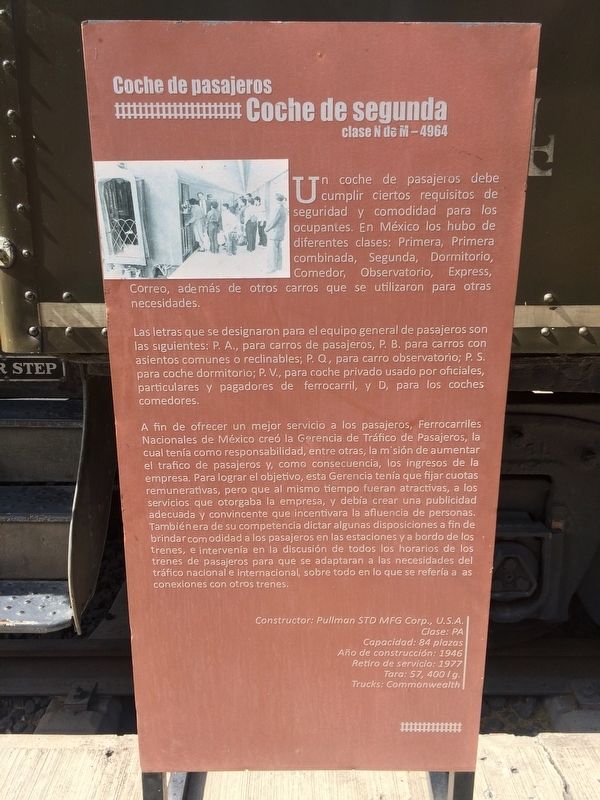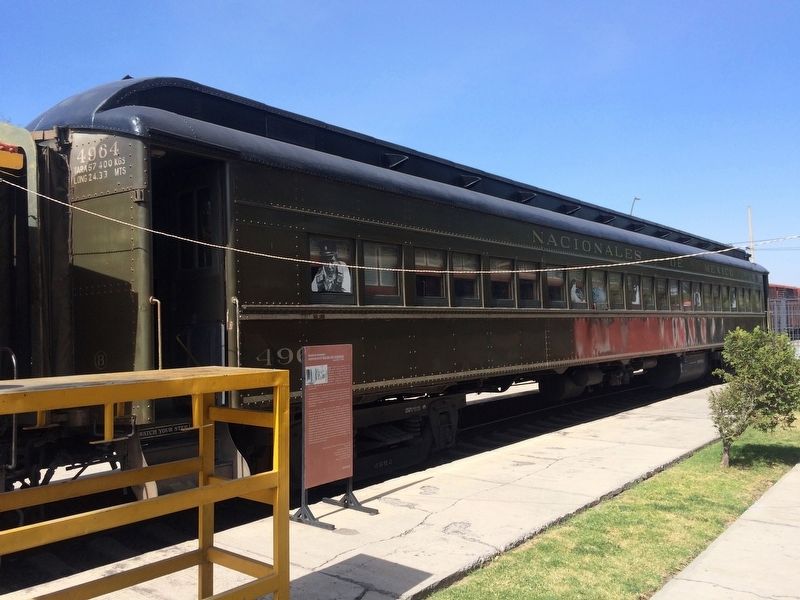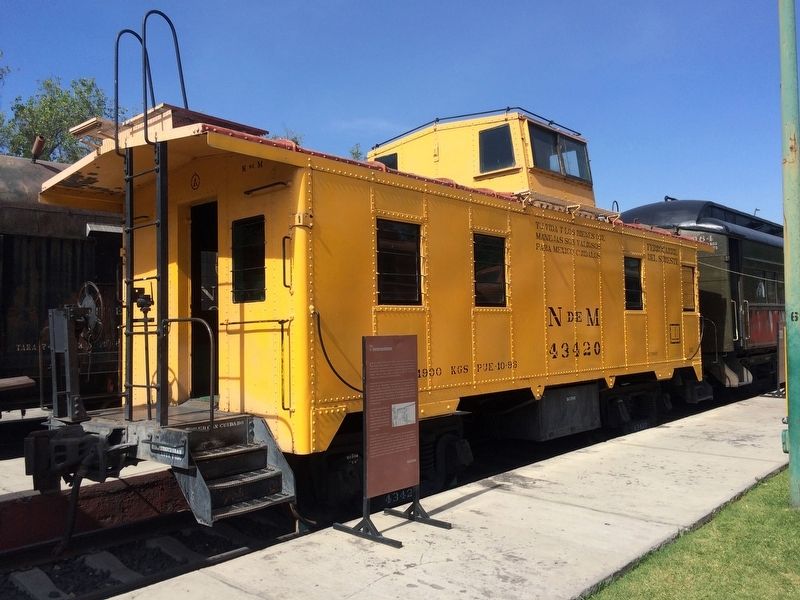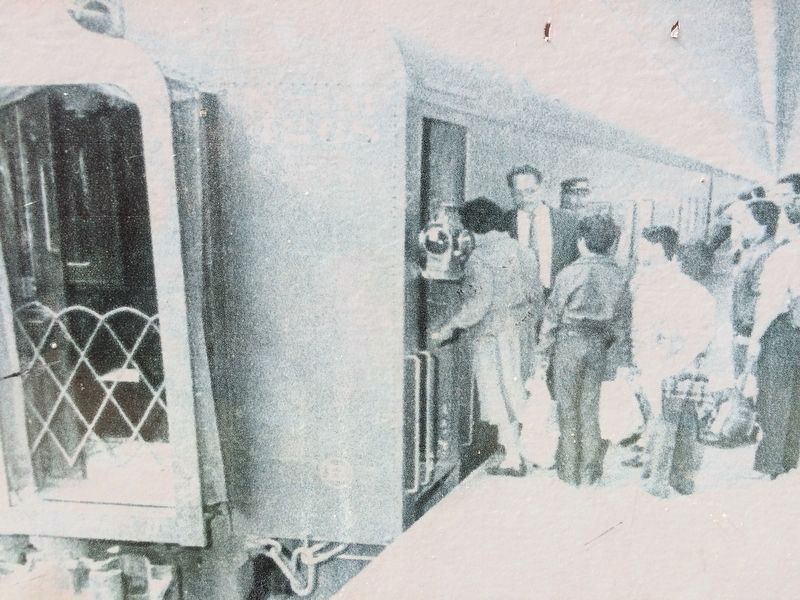Puebla, Mexico — The Central Highlands (North America)
Passenger Car
Second Class Car NM-4964
Coche de pasajeros
Coche de segunda clase N de M-4964
Un coche de pasajeros debe cumplir ciertos requisitos de seguridad y comodidad para los ocupantes. En México los hubo de diferentes clases: Primera, Primera combinada, Segunda, Dormitorio, Comedor, Observatorio, Express, Correo, además de otros carros que se utilizaron para otras necesidades.
Las letras que se designaron para el equipo general de pasajeros son las sıguientes: P. A., para carros de pasajeros, P. B. para carros con asientos comunes o reclinables; P. O., para carro observatorio; P. S. para coche dormitorio; P. V., para coche privado usado por oficiales, particulares y pagadores de ferrocarril, y D, para los coches comedores.
A fin de ofrecer un mejor servicio a los pasajeros, Ferrocarriles Nacionales de México creó la Gerencia de Tráfico de Pasajeros, la cual tenía como responsabilidad, entre otras, la misión de aumentar el trafico de pasajeros y, como consecuencia, los ingresos de la empresa. Para lograr el objetivo, esta Gerencia tenía que fijar cuotas remunerativas, pero que al mismo tiempo fueran atractivas, a los servicios que otorgaba la empresa, y debía crear una publicidad adecuada y convincente que incentivara la afluencia de personas. También era de su competencia dictar algunas disposiciones a fin de brindar comodidad a los pasajeros en las estaciones y a bordo de los trenes, e intervenía en la discusión de todos los horarios de los trenes de pasajeros para que se adaptaran a las necesidades del tráfico nacional e internacional, sobre todo en lo que se refería a las conexiones con otros trenes.
Constructor: Pullman STD MFG Corp., U.S.A
Clase: PA
Capacidad: 84 plazas
Año de construcción: 1946
Retiro de servicio: 1977
Tara: 57,400 kg.
Trucks: Commonwealth
English translation:
Passenger Car
Second Class Car NM-4964
A passenger car must meet certain safety and comfort requirements for the occupants. In Mexico there were different classes: First, First Combined, Second, Sleeper, Dining room, Observatory, Express, Mail, in addition to other cars that were used for other needs.
The letters designated for the general passenger cars were the following: P. A., for passenger cars, P. B. for cars with common or reclining seats; P. O., for observatory cars; P. S. for sleeping cars; P. V., for private cars used by officers, individuals and railway payers, and D, for dining cars.
In order to offer a better service to passengers, Mexican National Railroads created the Passenger Traffic Management Office, which was responsible, among other tasks, for the mission of increasing passenger traffic and, as a consequence,
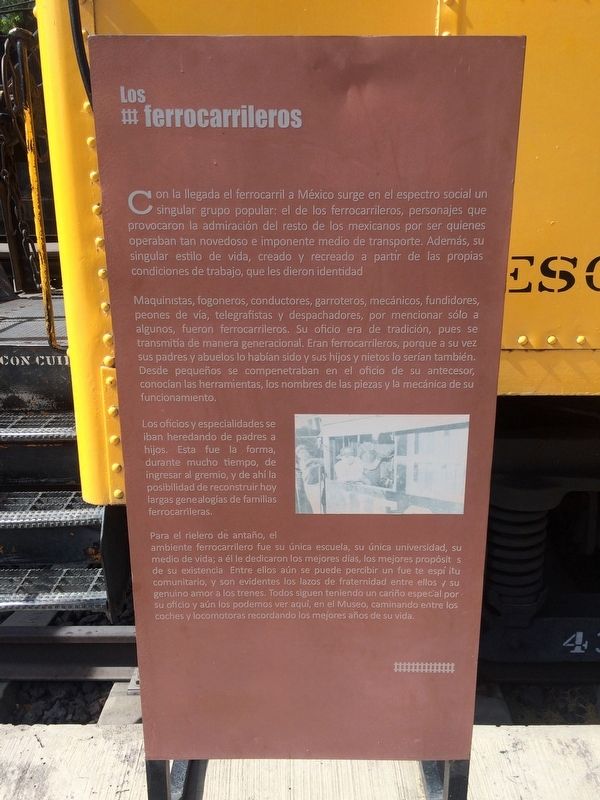
Photographed By J. Makali Bruton, December 1, 2017
2. An additional nearby marker on 'The Railroad Men'
This nearby marker is some steps to the south from the featured marker, near a yellow caboose. It doesn't present historical information, but is interesting in that it describes the life of those that worked on the railroads in Mexico. It's text can be found in the 'Additional Comments'.
Builder: Pullman Mfg. Corp., U.S.A
Class: PA
Capacity: 84 seats
Year of construction: 1946
Withdrawal from service: 1977
Tare: 57,400 kg
Trucks: Commonwealth
Topics. This historical marker is listed in these topic lists: Industry & Commerce • Railroads & Streetcars. A significant historical year for this entry is 1946.
Location. 19° 3.219′ N, 98° 12.232′ W. Marker is in Puebla. Marker can be reached from Calle 11 Norte just south of Avenida 14 Poniente, on the right when traveling south. The marker is on the grounds of the Mexican National Railroad Museum, just northwest past the first row of engines and cars after the entrance and near the Passenger Car display. Touch for map. Marker is in this post office area: Puebla 72090, Mexico. Touch for directions.
Other nearby markers. At least 8 other markers are within walking distance of this marker. FT Diesel-Electric Locomotive (a few steps from this marker); Steam Crane NM-0-19638 (a few steps from this marker); Steam Engines (a few steps from this marker); The Railway Stations of Puebla (a few steps from this marker); The Hero of Nacozari (within shouting distance of this marker); Railroads in the Mexican Revolution (within shouting distance of this marker); National Railroads of Mexico (within shouting distance of this marker); Steam Locomotive NM-601 (within shouting distance of this marker). Touch for a list and map of all markers in Puebla.
Additional commentary.
1. 'The Railroad Men' - text of the additional marker seen in photo #2
Los ferrocarrileros
Con la llegada el ferrocaril a México surge en el espectro social un singular grupo popular: el de los ferrocarrileros, personajes que provocaron la admiración del resto de los mexicanos por ser quienes operaban tan novedoso e imponente medio de transporte. Además, su
singular estilo de vida, creado y recreado a partir de las propias condiciones de trabajo, que les dieron identidad.
Maquinistas, fogoneros, conductores, garroteros, mecánicos, fundidores, peones de vía, telegrafistas y despachadores, por mencionar sólo a algunos, fueron ferrocarrileros.
Su oficio era de tradición, pues se transmitía de manera generacional. Eran ferrocarrileros, porque a su vez sus padres y abuelos lo habían sido y sus hijos y nietos lo serían también. Desde pequeños se compenetraban en el oficio de su antecesor, conocían las herramientas, los nombres de las piezas y la mecánica de su funcionamiento.
Los oficios y especialidades se iban heredando de padres a hijos. Esta fue la forma, durante mucho tiempo, de ingresar al gremio, y de ahí la posibilidad de reconstruir hoy largas genealogías de familias ferrocarrileras.
Para el rielero de antaño, el ambiente ferrocarrilero fue su única escuela, su única universidad, su medio de vida; a él le dedicaron los mejores días, los mejores propósitos de su existencia. Entre ellos aún se puede percibir un fuerte espíritu comunitario, y son evidentes los lazos de fraternidad entre ellos y su genuino amor a los trenes. Todos siguen teniendo un cariño especal por su oficio y aún los podemos ver aquí, en el Museo, caminando entre los coches y locomotoras recordando los mejores años de su vida.
English translation:
The Railroad Men
With the arrival of the railroad to Mexico, a singular popular group emerged on the social spectrum: that of the railroad men, characters that provoked the admiration of the rest of the Mexicans for being the ones who operated such a novel
and imposing means of transportation. His unique style of life, created and recreated from their own working conditions, gave them their own identity.
Machinists, stokers, drivers, errand-boys, mechanics, smelters, track-boys, telegraph operators and dispatchers, were only a few of the many that worked on the railroad. His trade was one of tradition, because it was transmitted by generations. They were railroaders, because in turn their parents and grandparents had been and their children and grandchildren would be too. From the time they were little they got involved in the trade of their father, they knew the tools, the names of the pieces and the mechanics of their operation.
The trades and specialties were inherited from parents to children. This was the way, for a long time, of entering the guild of the railroad man, and because of this it is possibile to reconstruct today long genealogies of railroad families.
For the railroad man of yesteryear, the railroad environment was his only school, his only university, his way of life; he spent the best days, the best part of his existence, on the railroad. Among them we can still perceive a strong community spirit, and the ties of fraternity between them and their genuine love for trains are evident. They all still have a special fondness for their craft and we can still see them here, in the Museum, walking among the cars and locomotives remembering the best years of their lives.
— Submitted December 14, 2017, by J. Makali Bruton of Accra, Ghana.
Credits. This page was last revised on December 14, 2017. It was originally submitted on December 14, 2017, by J. Makali Bruton of Accra, Ghana. This page has been viewed 127 times since then and 6 times this year. Photos: 1, 2, 3, 4, 5. submitted on December 14, 2017, by J. Makali Bruton of Accra, Ghana.
